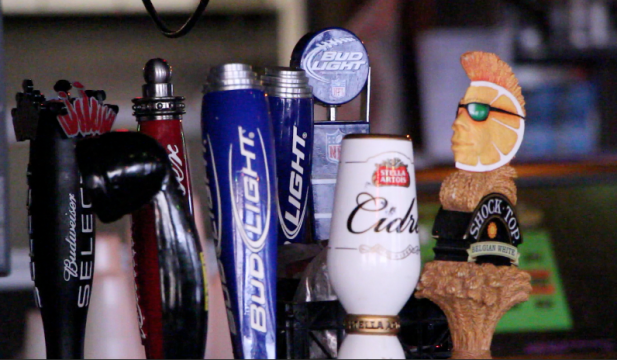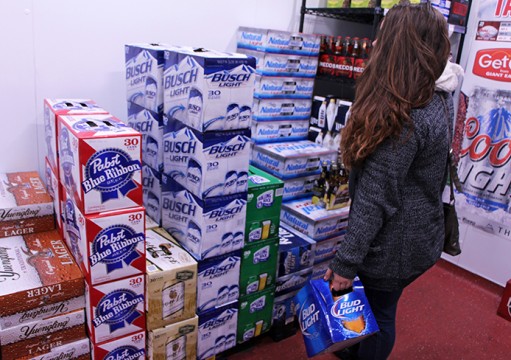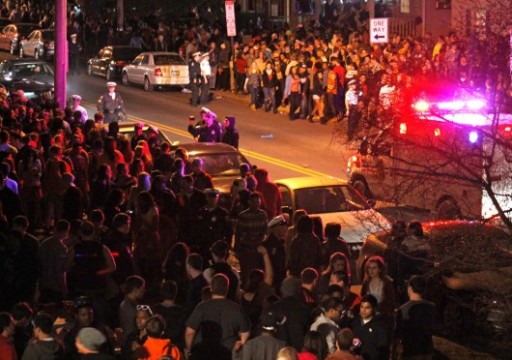“If kegs, liquor and loud music are what you want, then Ohio State fits the bill.”
At least, that’s what The Lantern wrote after OSU was named the No. 15 party school in the country in 1998. And an alumnus from 1984 said he remembers there being off-campus parties with “a trash container just full of liquor.”
Jim Grega, who graduated with a degree in productions operations in 1984, said though, that nobody he hung out with “ever got drunk to the point of not being able to take care of themselves.”
Haley de Leon, a current fourth-year in social work, said she didn’t think drinking had ever interfered with her academics.
But OSU has been trying to figure out how to deal with alcohol seemingly since it opened its doors in 1870.
One of The Lantern’s first mentions of alcohol was in an 1895 article that said “alcohol is called the water of life, though this is not so.” And that word — alcohol — would be repeated throughout the history of OSU and The Lantern.
In fact, it keeps coming back again, and again, and again.
Some of the highlights of alcohol initiatives and discussions in the past 50 years involve a committee formed in the 1970s that was dedicated to alcohol education. In the ‘80s, that educational push became a program. And in the ‘90s, there was a conference called to discuss alcohol abuse, while OSU was named the country’s No. 15 party school.
By the 2000s, OSU had completely renovated and rebuilt an off-campus area that had been known for its bars, and the off-campus area saw annual block parties get broken up by police.
The university received a $2 million grant in April to launch the Higher Education Center for Alcohol and Drug Misuse Prevention and Recovery. It was launched to help students who struggle with abusing alcohol or other types of substances, as well as research solutions that could reduce issues, and sits on campus in Stillman Hall, the home of the College of Social Work.
Office of Student Life spokesman Dave Isaacs said OSU hopes the center will become a national model in substance abuse recovery.
“(It) will be helping not just Ohio State, but helping colleges and universities nationally deal with issues of prescription drug abuse and misuse as well as alcohol misuse and abuse,” he said.
And the Collegiate Recovery Community at OSU has an on-campus residence hall where students who are in recovery from addiction can live together. There are 28 beds in the residence hall, though the CRC estimates that 950 students are in recovery at OSU.
The new center and the on-campus residence hall are far from the first time OSU has taken initiative to try and figure out how to combat alcohol abuse, though.
The 1970s: Alcohol abuse is cited as a problem
The OSU Alcohol Education Committee was formed in the ‘70s with the goal of “tackling alcohol problems on campus without preaching to or alienating students.”
It was led by hall directors and counselors from a mental health center, and resident advisers went through mandatory workshops to learn about the physical and psychological effects of alcohol.
Around the same time, in 1975, the chief of preventative medicine at the student health center, Dr. W. R. Garner, and the director of university health services, Dr. H. Spencer Turner, said alcohol abuse was a major health problem among students at OSU.
“Using alcohol to the extent that it significantly interferes in any activity that you want to do, or drinking for the sole purpose of getting drunk is alcohol abuse,” Turner told The Lantern in ‘75.
The Alcohol Education Committee started a program called DRIP, which stood for “Drinking Responsibly In Public,” in 1979, which sought to tell students about alternatives to drinking and was set to be offered every Thursday through Saturday. Students could call a phone number to find activities.
Grega said when he went to school starting in 1980, he didn’t know much about those programs because everyone he knew ignored them.
“As students, we all got drunk at some point. We didn’t pay much attention to (the programs) and no one took them seriously,” he said.
The 1980s: University funding is low
The Alcohol Education Committee disbanded in 1985, and by 1986, the university’s Alcohol Education Program (founded in ‘85) only received $1,000 in funding — despite the athletic department spending $150,000 a year for drug testing alone. That left OSU trailing behind many others in both funding and organization of alcohol abuse programs, according to a 1986 Lantern article.
Grega said alcohol was always easy for him to come by, despite university efforts to encourage non-alcohol related activities.
“Someone would have a party somewhere and you would come with your six to 12 pack of beer and there would be a keg of beer at a party and added bottles of liquor that were brought by partygoers,” he said.
He added that, “there used to be parties called ‘hairy buffalo parties’ where you filled a big trash container just full of liquor.”
In a 1986 Lantern article, the part-time coordinator of the Alcohol Education Program stressed that OSU needed someone to work full time to make a commitment to educating students on alcohol.
Perhaps that’s where the new center will come in, or the counseling services, but currently, it doesn’t seem that one person has a title of alcohol educator, or alcohol overseer, or official alcohol counselor at OSU.
The part-time coordinator in ‘86 estimated that 29 percent of academic failures were a result of alcohol abuse. She also said in ‘86 that about 60 percent of university-area causes of vandalism and physical violence could be traced back to alcohol abuse.
Now, the National Institute for Alcohol Abuse estimates that about 25 percent of students face academic repercussions because of drinking. The NIAA also says:
- About 599,000 students between the ages of 18 and 24 receive unintentional injuries while under the influence of alcohol.
- More than 690,000 students are assaulted by someone else who had been drinking.
And about 80 percent of students drink, according to the NIAAA. Half of those are binge drinking, which is having about four drinks in two hours for women, or five drinks in that time for men, according to the NIAAA.
The 1990s: OSU looks at drinking on gamedays, party school ranking
In 1996, OSU held a conference with students and administrators from 22 other Ohio universities. At that time, officials suggested that tailgating outside Ohio Stadium before football games could lead to binge drinking. The officials added that tailgating gave students conflicting messages about whether binge-drinking alcohol was acceptable.
Students and officials at the conference noted then that drinking outside the stadium was illegal, but it seems little has been done to curb people from carrying open containers of alcohol while tailgating.
From the first home football game this year on Sept. 6 to the last on Nov. 29, there were 68 open container violations reported by University Police on campus during home gamedays. Many of those were in parking lots set aside for tailgating.
David Rose, Captain in the OSU Police Division, said he hasn’t noticed changes in how the police force goes about handling open container violations since he began working with OSU police in 1992.
“From an enforcement standpoint, it seems like its been pretty consistent with the exception of enhanced enforcement during football game days — 2002 was when enhanced enforcement started,” Rose said.
University Police’s daily log records don’t go back to 1996, so it’s hard to say if that’s a decrease from when the conference was held, but between Sept. 6 and Wednesday, there were only 68 violations total — meaning all of the open container violations reported on campus occurred during gamedays.
Bob Mural graduated from OSU in 1979 with a degree in business administration and again in 1983 with a degree in civil engineering. He said he’s noticed a different atmosphere on gamedays in Columbus now than when he attended school.
“Coming in as alumni now on gameday, they are clamping down a lot harder on drinking,” Mural said. “I think they wanted to stop a lot of the younger drinkers, but my son just graduated and my daughter is there now and they find ways to party anyways.
“If there’s a will there’s a way.”
Grega, from ‘84, said he would tailgate before the game — often out of the back of someone’s van parked near the stadium that was set up like a bar with a full liquor cabinet.
“After the game, we’d go back to the tailgate and keep drinking and into Saturday night, we would go out on High Street and continue,” Grega said.
De Leon, the current student, said she’s experienced drinking get out of hand at games, too.
“I’ve definitely seen other college students walking to the game and it appears they may be drinking too much or seeing other people at the game throwing up,” she said.
In other current-day alcohol-related police calls, between the first and last days of Fall Semester, there were 56 reports of underage offenses on campus.
Grega, Mural and de Leon all said they started drinking in the dorms.
Ohio’s drinking law changed to only allow those 21 and older to drink in 1987. Previously, those 19 and older were allowed to have alcohol.
Even so, alcohol wasn’t allowed in the dorms, Grega said, but students still did it anyway.
“We weren’t supposed to have alcohol in the dorms, but before the evening started, we probably had one or two drinks before we went out,” he said.
Two years after that conference that discussed the possible negative effects of tailgating, in 1998, OSU was ranked the nation’s 15th-best party school by the Princeton Review.
“If kegs, liquor and loud music are what you want, then Ohio State fits the bill,” The Lantern wrote in ‘98.
And it seems that OSU had fit that description for a while.
OSU had said just four years previously that it wanted to try to nix the idea that the university was just a party school and wanted the university to refocus on research. Some proposed solutions: more selective admission policies and emphasis on the quality of educational services and quality of life.
The 2000s: South Campus Gateway transforms
The South Campus area was completely transformed in the 2000s after a revitalization project led by OSU’s development arm, Campus Partners. The project spent about $15 million to buy land from existing owners and businesses — including properties that forced tenants to move (although Campus Partners paid those affected $250).
The Lantern wrote in 1998 that “the area between 9th and Chittenden avenues on High Street will be unrecognizable to current Ohio State students.”
Mural said when he was at OSU in the ‘80s, there were “so many bars on South Campus.”
“The amount of bars … was crazy compared to now,” he said, adding that a lot of the bars would sell beer in big buckets for low prices.
Now: OSU plans initiatives for the future, battles block parties
Now, OSU no longer ranks on the party school list, but there are still annual block parties that have drawn thousands of participants and drawn police attention for years.
Less people were arrested this spring than in the past at Chittshow (a block party that takes place on Chittenden Avenue), but police used pepper spray in 2013 to break up that event and another one that takes place on Woodruff Avenue.
Meanwhile, the Alcohol Education Program and the Alcohol Education Committee from the ‘70s no longer exist, but the Student Wellness Center and OSU’s Counseling and Consultation Service both offer programs for alcohol abuse.
The Student Wellness Center offers an alcohol screening test for “all OSU students who may want to explore their alcohol and drug use,” according to its website. The main goal of the Brief Alcohol Screening and Intervention for College Students, though, is to reduce risky behaviors and harmful consequences of alcohol abuse.
The program involves two approximately one-hour, one-on-one sessions with a facilitator.
Shivani Edwards, the assistant director of clinical services at OSU’s Counseling and Consultation Service, said CCS also has group and individual sessions available, among other ways to help students.
She said, though, if a student has a serious problem with alcohol, it could require more action than counseling.
“Alcohol is one of those drugs that is dangerous if you’re using it in a prolonged manner or in an excessive manner so being under the supervision of a physician is highly recommended,” Edwards said.
She said OSU has helped students find inpatient drug and alcohol centers in their hometowns or around the Wexner Medical Center, and also helps students who already have received help for a problem.
At OSU, Talbot Hall has inpatient and outpatient resources for people recovering from drug addiction or alcoholism. Edwards said students are often referred to the program, which was launched in 1974.
“We have a fair number of students who call because they’ve come out of a rehab center successfully and they want support from CCS,” she said.
Mural said he’s seen alcohol change along with the way the university has changed — both physically and academically.
“Drinking is different at Ohio State now but it’s a different Ohio State than it was — back then you had a 2.0 and you got in,” he said. “It’s different now.”






